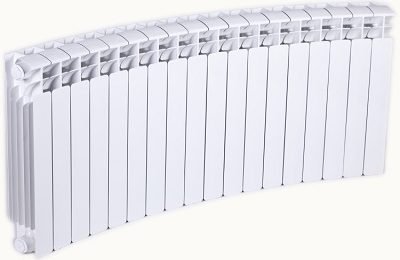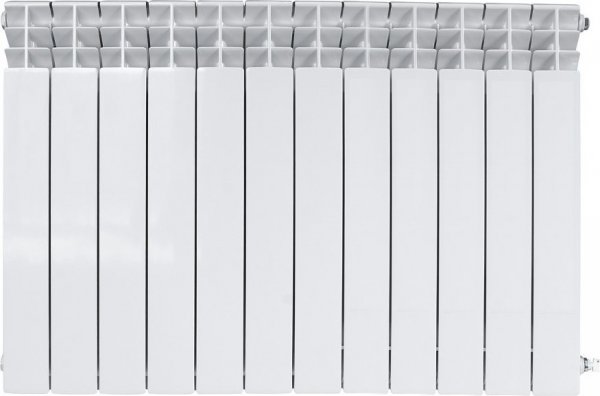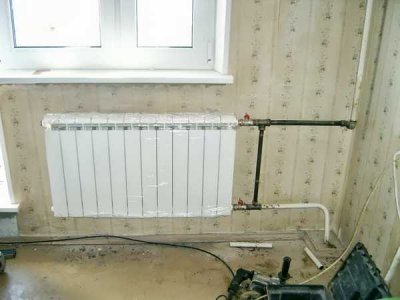Which is a better calculation of sections of bimetallic heating radiators: by area or by volume?

Thanks to the correct calculations of the number of sections for bimetallic radiator you can create a comfortable temperature in the room, regardless of the weather outside.
And you will also be able to cut costs wisely for heating, which will benefit your wallet, but without compromising comfort.
If you want use natural resources wisely, do not want to freeze in the cold season and do not want to overpay for heating, then replace the batteries with more energy-efficient ones. And before replacing or buying new radiators, you need to calculate how many sections it should have.
How to calculate heat output of a bimetallic radiator and one section
The power of a bimetallic radiator is related to its capacity and size. The less carrier in the battery, the more efficient and economical it is. The reason is small amount of water, which heats up faster, therefore much less electricity is consumed.

Photo 1. Bimetallic radiator Bimetal 500/80, heat output - 2280 W, manufacturer - "Konner".
Calculation of the number of sections
For each room, a calculation of the required number of sections is made. A number of factors are taken into account for this: product model, heat output level and room area.
| Radiator model | Heat output (kW) | Room area (with a ceiling height of 2.7 meters) | ||||||||||||||||
| 8 | 10 | 12 | 14 | 6 | 18 | 20 | 22 | 24 | 26 | 28 | 30 | 32 | 34 | 36 | 38 | 40 | ||
| The required number of sections | ||||||||||||||||||
| Bimetal 350 | 136 | 7 | 8 | 9 | 0 | 12 | 13 | 14 | 15 | 16 | 17 | 18 | 19 | 20 | 21 | 22 | 23 | 24 |
| Bimetal 500 | 204 | 6 | 7 | 8 | 9 | 11 | 12 | 13 | 14 | 15 | 16 | 17 | 18 | 19 | 20 | 21 | 22 | 23 |
Methods for assessing heat transfer based on room dimensions
To correctly calculate and select the right model by area and size, first find out how many sections will be required for heating 1 sq. m. The easiest way to calculate by the area of the room.
By area per square meter
The calculation formula is as follows:

- N = S/P x 100.
- N — number of sections.
- S — the area of the room.
- P — kW in each section.
For example, for a room with an area of (3x4) 12 sq. m. you need to make the following calculations: 12 sq. m.x100/200W = 6 (12 m2x100/200W).
So, for this room you need 6 sections, but it is important to consider that these calculations are approximate. There are factors that can influence the increase in the number of sections. This is the presence of an uninsulated balcony, two external walls and cold bridges, which do the work of the radiator less effective.
To obtain more accurate readings It is also important to consider the ceiling height, location of windows, connection method, quality of insulation of external walls and their presence.
Heat transfer of bimetallic heating radiators directly depends on several parameters, which, when combined, will show how many sections are required to accommodate a certain area.
As the practice of using bimetal in apartments with central heating shows, it is correct calculated power allows you to heat the room efficiently and significantly save money for payment of utility bills.
Attention! The lack of calculation by area is that the indicators are obtained approximate.
To have an exact idea of how many sections a bimetallic radiator should have, use other formulas. For example, calculation by volume.
By volume
Based on the center distance, the radiator volumes may vary:

- 200 mm - 0.1-0.16 l.;
- 350 mm - 0.17-0.2 l.;
- 500 mm - 0.2-0.3 l.
It turns out that if in the design 10 sections and center distance 200 mm, then the volume of water is equal to from 1 to 1.6 liters.
For 10 with center distance 350 mm the volume of water is from 1.7 to 2 liters. If you take 10 pieces with center distance 500 mm, then the volume of water will be 2-3 liters. The most popular bimetallic options are models with 8, 10, 12, 14 sections.
It is also possible to perform calculations by volume. 41 W is required per 1 sq. m. Calculate the parameters based on the following formula:
- V=length*width*height (in meters) = volume in cubic meters.
As a result, you can find out the heat output of the battery.
- P=V*41= number in watts.
And then select batteries based on these indicators. If the calculation does not result in a whole number, then round up (for example: 6.3 round up to 7).
Correction factors
Actual heat output may differ from that stated in the passport. They are affected by operating conditions. Therefore, remember the correction factors B1 and B2.
| Radiator type | Radiator height, mm | B1 | B2 | |
| When installed against an external wall | When installed on external glazing | |||
| 10 | 300 | 1,005 | 1.04 | 1,1 |
| 10 | 500 | 1.01 | ||
| 11.2 | 300 | 1.02 | ||
| 11.2 | 500 | 1,027 | 1.03 | 1.08 |
| 21 | 300 | 1,035 | 1.02 | 1.06 |
| 500 | 1.05 | |||
| 22 | 300 | 1.08 | - | 1.04 |
| 500 | 1.09 | |||
| 33 | 300 | 1.15 | 1.01 | 1.02 |
| 500 | 1,2 | |||
Multiply the number obtained from the calculation by the coefficient:
- north and corner room 1.3;
- areas with severe frosts 1.6;
- boxes and screens (can be added 20%, if the niche is - 7%);
- 100 for window the heat output in the room increases, 200 for the door.
Useful video
Check out this video that explains the different methods for calculating the number of radiator sections.
What is the capacity of the heating battery?
Remember that cast iron radiators heat worse than bimetallic ones. Therefore, it is reasonable to replace cast iron with bimetallic ones. But also remember if:

- indoors 1 window and two external walls - increase the battery power by 20%;
- two windows in the room and two external walls - the power should be increased by 30%;
- windows facing north and northeast - increase power by 10%;
- the radiator is in a deep but open niche - the power should be increased by 5%;
- the battery is covered by a panel - increase the power by 15%.
Use all formulas to get the most accurate numbers. And also pay close attention to coefficients and efficiency factors, which affect how many sections there should be in the bimetal.
In this case you you will definitely be able to choose the ideal model, which will heat the room at any time of the year. And will help you create the ideal temperature in the room, protect you from overpaying for heating and give you comfort in any weather outside.





